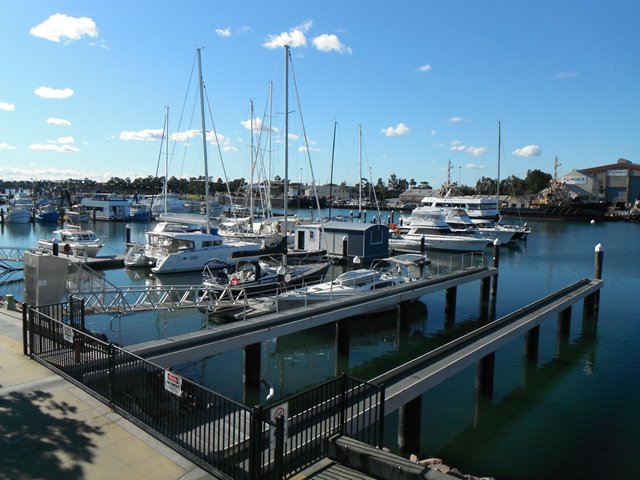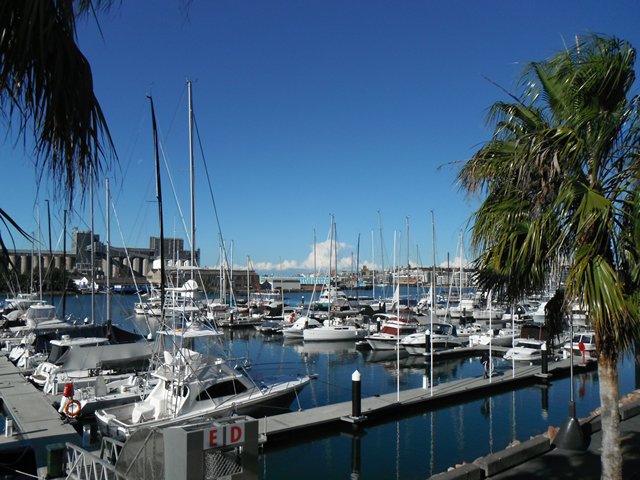Underway at last - Newcastle 32 55.192S 151 45.651E

Aurora_b
Mike and Liz Downing
Tue 18 Jun 2013 12:07
|
Underway at last, but not that far - a 56 mile
passage up the coast to the city of Newcastle. The forecast was
definitely a bit iffy - winds of 25-30kts, seas of 2.5 to 3m combined with
a south south east swell of 2.5 to 3m. But the one good point was that the
wind direction was from the west or southwest, so an offshore wind. That, we
thought, made it a possibility. The forecast for the following 2 days had
similar winds, but going round to the south, and swell increasing to
4m or more. So if we didn't go it looked like we would have to wait another 3
days. Fitting the trisail (storm sail) in the hope it would ward off the
worst of the weather, we left at first light yesterday, keeping around the
50m contour line which cleared all dangers and kept us about 4 miles off
the coast. This proved to be just about right. As we were to find out, further
out the winds were stronger and the sea definitely quite ugly. For
most of the passage along the 50m contour the winds were 15
to 25 with occasional gusts in the early 30s, and the seas stayed around 2 to 3m
from the south. With this we set our outer genoa poled out to windward
and the inner genoa sheeted normally (both reefed as needed to keep the
boat balanced and going at a comfortable speed for the conditions) and that
combination (and no main) kept our speed over the ground
(SOG) at around 6.5 to 7.5kts. The current was against us,
but with our log not working we didn't know how fast the boat
was going through the water. (New Zealand and Australian waters seem to
kill the log with fouling within a few days if we don't move. In
warmer waters I would have dived underneath the day before we left to get it
working, but it's far too cold for that down here! At these times I think fondly
of our walkers trail log that attaches to the pushpit. It's accurate, easy
to clean (as it's just a spinner on the end of a line that we trail and at
home!)
With 15 miles or so still to go we encountered the first
of several anchored ships. It was in fact directly on our line so we could
roll away the poled out sail (losing speed) and change course to go inside it or
keep the sails as they were and go outside it. We chose the latter to keep
the speed up. It didn't take long before the wind was up and the seas breaking
and confused, with Aurora B surfing down the waves. And it didn't take long once
well clear of the ship to roll away the poled out genoa and change
course to go back to our nice 50m line. Once there, it was back on course and
the genoa poled out once again. And to welcome us back, a pod of 20 or
so common dolphins surrounded the boat, taking it in turns to bow ride or leap
from the water. They stayed with us for a good 30 minutes and it
was wonderful to watch. They were so close that when the bows went down in
the swell you could reach out and almost touch them. We've seen so few dolphins
in the Pacific and nothing to match this since 2010.
Newcastle is largest coal exporting port in the
world. Large (700 to 900ft) ships arrive empty from Asia (mostly China from
what we could see) to fill up with coal and return home. On AIS
we could count 10 ships waiting for their turn to enter the port. Having
arrived we discovered that these ships are so large (with deep draft) that they
can only get into the port around high tide, so that's a busy time with ships
coming and going, each ship often accompanied by 3 tugs. And what time did we
arrive? You guessed it, high tide. Having called Port Control to find out what
movements were scheduled we decided to wait outside a while and let the
commotion die down before going in. Once in we also found out why ships are
anchored so far out to sea. The winds along this coast can be severe and are
often from the east or southeast, making it a lee shore. When empty the ships
are often not heavy enough for their propellers to be fully submerged, making
them much less effective. So if they get caught in severe onshore winds and
their anchors drag, they can't be sure their engines will be able to get them
back out to sea and they end up dragging ashore. It's happened to a few and
now the port authorities insist that no ship should be anchored closer
than 3 miles from the shore. This presumably gives them enough time to get tugs
out to help should this situation develop. We found this out listening
to the Port Control telling one of the ships that it was
anchored within 3 miles of the shore and must up anchor and re-anchor
further out. It's not that nice even for a big ship (900ft in length)
when anchored in big swell. The ones we past, all being empty and high out of
the water, were pitching and rolling from side to side, much more than we
were (but then we had the steadying wind in the sails and Aurora B is now
far from empty, as we add more and more each year she's getting heavier and
heavier).
Leaving at first light it was very cold so today the
priority was to go shopping for thick socks!
 The marina at Newcastle. With no obvious
place to anchor and, much more importantly, with
our dinghy deflated and packed away for
passage, and so no way to get ashore, we opted for
the marina. In by book 'Showers of the
Pacific' they will get 9.9 out of 10 (excellent, but
there's
always room
for some improvement!). The
tram way over the water is for the travel lift
(crane)
to lift boats in and out of the
water.
 Looking the other way, with cargo terminals
in the background and palm trees along the
developed walkway in front of the
marina.
 An unusual sculpture we
passed when walking in to the city. They do
have a
small fishing fleet here.
|